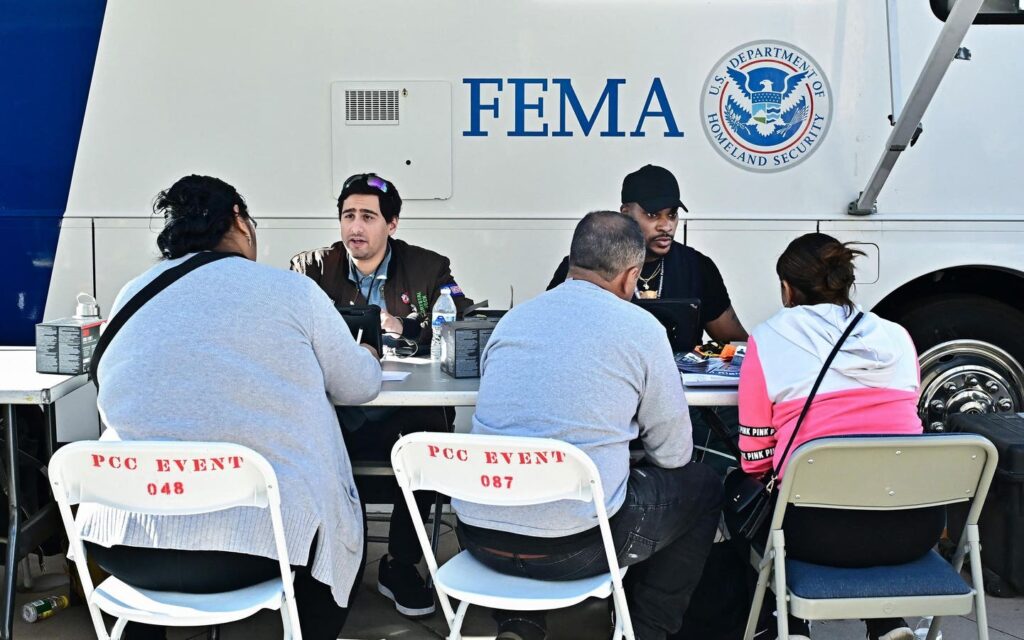Fire-affected residents meet with FEMA officials on January 14, 2025 in Pasadena, California, where … More
AFP via Getty ImagesWith FEMA defunded and state programs slashed, individuals and communities must reassess how to prepare for hurricane season and recover in its aftermath. Local strategies, mutual aid, and policy reforms are more important than ever. The 2025 Atlantic hurricane season arrives amid unprecedented shifts in federal disaster management. FEMA, the country’s primary emergency response agency, has undergone significant cuts, with several programs suspended or eliminated outright. For communities already on the front lines of climate change, these changes raise urgent questions. Who responds when FEMA doesn’t? And how should people prepare now?
How We Got To Hurricane Season With No FEMA
This year, the federal government moved to eliminate or curtail many FEMA grant programs that had long supported community preparedness and disaster recovery. The agency’s April press release described the shift as a return to its “core mission” by ending “wasteful, politicized grant programs” and prioritizing streamlined disaster response.
But critics see it differently. The Union of Concerned Scientists warned that “eliminating FEMA will endanger millions,” especially in states with high exposure to climate risks. According to their analysis, the changes appear to be part of a broader effort to politicize disaster aid, disproportionately affecting marginalized and vulnerable populations. As hurricane season intensifies, individuals and communities are left wondering what support will remain if federal resources disappear or never arrive at all.
Hurricane Season With No FEMA – What Preparedness Looks Like Now
Preparedness is not just a federal government function. It can happen at any level and be done by anyone. Here are five practical steps for storm season preparedness, from securing temporary housing to documenting damage for insurance. But when FEMA is no longer a guaranteed safety net, preparation becomes even more local and personal.
Here are a few updated approaches:
- Document everything now. Store important documents (ID, insurance, prescriptions) digitally and in waterproof containers.
- Know your local mutual aid groups. In the absence of federal coordination, grassroots and church-based groups often mobilize faster than formal agencies.
- Pre-map evacuation options. With federal shelter coordination potentially reduced, ensure your household has multiple routes and destinations planned in advance.
As pointed out in an earlier article, “Hurricane preparedness is no longer just about stocking up—it’s about strategizing for longer-term instability.”
A woman buys provisions and non-perishable foods at a supermarket in preparation for the arrival of … More
AFP via Getty ImagesWhat This Means for States, Cities, And Communities
States now face more pressure to fill the gaps. However, many disaster-prone states already struggle with limited emergency management capacity. A bipartisan proposal introduced in Congress aims to re-establish FEMA’s foundational mission and restore the Disaster Relief Fund. But for now, the bill’s prospects remain uncertain.
In the meantime, cities are stepping up. Some are investing in localized emergency alert systems and weatherizing community infrastructure. Others are formalizing relationships with nonprofits and businesses to coordinate emergency response more efficiently. Still, without federal coordination, disparities will likely deepen. “States most vulnerable to extreme weather—especially across the Gulf South—now face this crisis with less federal support than in decades,” noted a recent AP report.
What You Can Still Count On As We Start Hurricane Season With No FEMA
Federal emergency declarations may still activate a limited FEMA response, particularly for large-scale catastrophes. But smaller disasters, or those affecting rural and underserved communities, may fall below the threshold for aid. It’s essential to:
- Check your flood and wind insurance status now. FEMA’s National Flood Insurance Program (NFIP) is still active, but private policies may offer quicker payouts.
- Connect with neighbors. Shared transportation, emergency communication networks, and community watch plans can help reduce isolation and risk.
- Use trusted tools. The Red Cross Hurricane App and NOAA’s local alerts remain critical sources of information.
ASHEVILLE, NORTH CAROLINA – OCTOBER 04: A member of the FEMA Urban Search and Rescue Task Force … More
Getty ImagesWhy These Changes Matter
The shift in FEMA’s structure reflects a broader change in how the federal government approaches disaster risk and social protection. Many of the grants now eliminated had supported long-term community resilience, particularly for Indigenous communities, low-income neighborhoods, and climate-exposed regions.
Without those programs, rebuilding is more difficult. But preparation still matters. As one Louisiana resident said after Hurricane Helene, “We don’t wait on FEMA anymore. We check on each other first.”
That sentiment captures both the challenge and the opportunity. In the face of more frequent storms and less federal relief, our greatest resource may be each other.
Read the full article here


